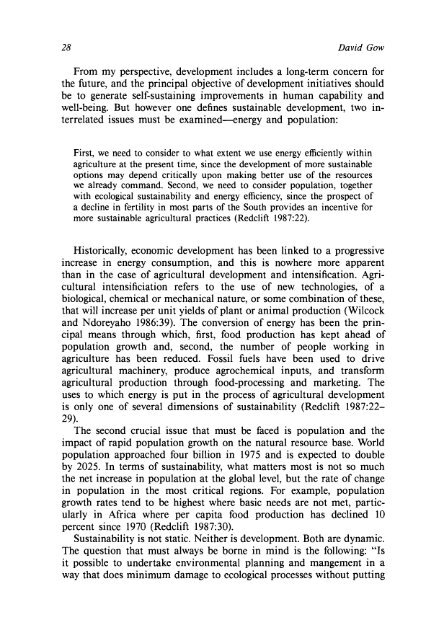Fragile Lands of Latin America Strategies for ... - PART - USAID
Fragile Lands of Latin America Strategies for ... - PART - USAID
Fragile Lands of Latin America Strategies for ... - PART - USAID
Create successful ePaper yourself
Turn your PDF publications into a flip-book with our unique Google optimized e-Paper software.
28 David Gow<br />
From my perspective, development includes a long-term concern <strong>for</strong><br />
the future, and the principal objective <strong>of</strong> development initiatives should<br />
be to generate self-sustaining improvements in human capability and<br />
well-being. But however one defines sustainable development, two in-<br />
terrelated issues must be examined-energy and population:<br />
First, we need to consider to what extent we use energy efficiently within<br />
agriculture at the present time, since the development <strong>of</strong> more sustainable<br />
options may depend critically upon making better use <strong>of</strong> the resources<br />
we already command. Second, we need to consider population, together<br />
with ecological sustainability and energy efficiency, since the prospect <strong>of</strong><br />
a decline in fertility in most parts <strong>of</strong> the South provides an incentive <strong>for</strong><br />
more sustainable agricultural practices (Redclift 1987:22).<br />
Historically, economic development has been linked to a progressive<br />
increase in energy consumption, and this is nowhere more apparent<br />
than in the case <strong>of</strong> agricultural development and intensification. Agri-<br />
cultural intensificiation refers to the use <strong>of</strong> new technologies, <strong>of</strong> a<br />
biological, chemical or mechanical nature, or some combination <strong>of</strong> these,<br />
that will increase per unit yields <strong>of</strong> plant or animal production (Wilcock<br />
and Ndoreyaho 1986:39). The conversion <strong>of</strong> energy has been the prin-<br />
cipal means through which, first, food production has kept ahead <strong>of</strong><br />
population growth and, second, the number <strong>of</strong> people working in<br />
agriculture has been reduced. Fossil fuels have been used to drive<br />
agricultural machinery, produce agrochemical inputs, and trans<strong>for</strong>m<br />
agricultural production through food-processing and marketing. The<br />
uses to which energy is put in the process <strong>of</strong> agricultural development<br />
is only one <strong>of</strong> several dimensions <strong>of</strong> sustainability (Redclift 1987:22-<br />
29).<br />
The second crucial issue that must be faced is population and the<br />
impact <strong>of</strong> rapid population growth on the natural resource base. World<br />
population approached four billion in 1975 and is expected to double<br />
by 2025. In terms <strong>of</strong> sustainability, what matters most is not so much<br />
the net increase in population at the global level, but the rate <strong>of</strong> change<br />
in population in the most critical regions. For example, population<br />
growth rates tend to be highest where basic needs are not met, partic-<br />
ularly in Africa where per capita food production has declined 10<br />
percent since 1970 (Redclift 1987: 30).<br />
Sustainability is not static. Neither is development. Both are dynamic.<br />
The question that must always be borne in mind is the following: "Is<br />
it possible to undertake environmental planning and mangement in a<br />
way that does minimum damage to ecological processes without putting

















